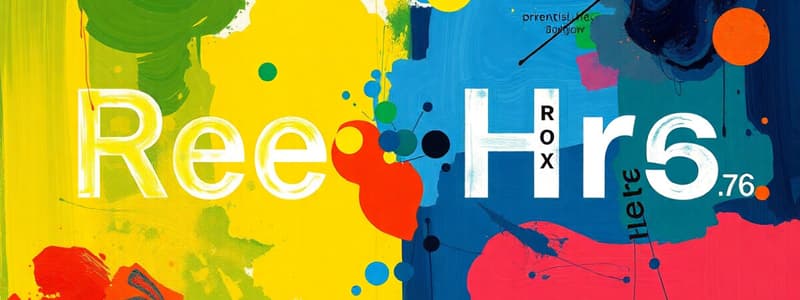Podcast
Questions and Answers
What is the oxidation state of chromium in the Na2Cr2O7 compound?
What is the oxidation state of chromium in the Na2Cr2O7 compound?
- +6 (correct)
- +3
- +4
- +2
In the redox reaction H2(g) + ½ O2(g) → H2O(l), which substance acts as the reducing agent?
In the redox reaction H2(g) + ½ O2(g) → H2O(l), which substance acts as the reducing agent?
- Oxygen
- Water
- Hydrogen (correct)
- None of the above
What is the total charge of the sulfate anion, SO4?
What is the total charge of the sulfate anion, SO4?
- -2 (correct)
- -3
- -1
- -4
Which of the following statements about the Activity Series is true?
Which of the following statements about the Activity Series is true?
What occurs to the reducing agent during a redox reaction?
What occurs to the reducing agent during a redox reaction?
What is the oxidation state of sulfur in the sulfate ion (SO4)?
What is the oxidation state of sulfur in the sulfate ion (SO4)?
Which of the following is a characteristic of redox reactions?
Which of the following is a characteristic of redox reactions?
Which metal is found lower than hydrogen in the Activity Series?
Which metal is found lower than hydrogen in the Activity Series?
What is the oxidation number of sulfur in CdS?
What is the oxidation number of sulfur in CdS?
In the reaction Mg(s) + 2 HCl(aq) → MgCl2(aq) + H2(g), what is oxidized?
In the reaction Mg(s) + 2 HCl(aq) → MgCl2(aq) + H2(g), what is oxidized?
Which of the following correctly identifies the reducing agent in the reaction between magnesium and hydrochloric acid?
Which of the following correctly identifies the reducing agent in the reaction between magnesium and hydrochloric acid?
What is the oxidation state of hydrogen in AlH3?
What is the oxidation state of hydrogen in AlH3?
What is the total charge of the polyatomic ion S2O32-?
What is the total charge of the polyatomic ion S2O32-?
In the compound Na2Cr2O7, what is the oxidation number of chromium?
In the compound Na2Cr2O7, what is the oxidation number of chromium?
What type of reaction occurs when magnesium reacts with hydrochloric acid?
What type of reaction occurs when magnesium reacts with hydrochloric acid?
What is the oxidation number of oxygen in peroxides?
What is the oxidation number of oxygen in peroxides?
Flashcards
Redox reaction
Redox reaction
A chemical reaction where electrons are transferred between reactants. One reactant loses electrons (oxidation) and another gains electrons (reduction).
Oxidation
Oxidation
The process of losing electrons, resulting in an increase in the oxidation number of an atom.
Reduction
Reduction
The process of gaining electrons, resulting in a decrease in the oxidation number of an atom.
Oxidation number
Oxidation number
Signup and view all the flashcards
Oxidizing agent
Oxidizing agent
Signup and view all the flashcards
Reducing agent
Reducing agent
Signup and view all the flashcards
Activity series
Activity series
Signup and view all the flashcards
Peroxide
Peroxide
Signup and view all the flashcards
Spontaneous reaction
Spontaneous reaction
Signup and view all the flashcards
Study Notes
Oxidation-Reduction Reactions (Redox)
- Redox reactions involve the transfer of electrons between reactants
- Oxidation is the loss of electrons
- Reduction is the gain of electrons
- The substance causing oxidation is the oxidizing agent
- The substance causing reduction is the reducing agent
- Oxidizing agent is reduced
- Reducing agent is oxidized
Assigning Oxidation Numbers
- Elemental form: Oxidation number of 0
- Monatomic ion: Oxidation number equals the charge
- Polyatomic ion/molecule: Oxidation number same as if it were a monatomic ion
- Hydrogen: +1 when bonded to a nonmetal, -1 when bonded to a metal
- Oxygen: Usually -2, except in peroxides (-1) or bonded to a more electronegative element
- Halogens: Usually -1, except when bonded to oxygen or fluorine (positive oxidation number)
- Sum of oxidation numbers: 0 for neutral compounds, equal to the total charge for a polyatomic ion
Activity Series
- The Activity Series ranks metals by their reactivity
- Higher metals are more reactive, more easily lose electrons, and more readily oxidized
- Metals higher than Hydrogen in the Activity Series will react with acids to form hydrogen gas
- More reactive metals react vigorously with cold water
- Gold is very unreactive and low in the Activity Series and will not react with simple acids
Studying That Suits You
Use AI to generate personalized quizzes and flashcards to suit your learning preferences.



